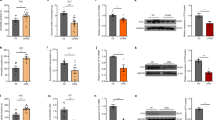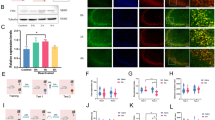Abstract
The formation of long-lasting memories requires coordinated changes in gene expression and protein synthesis. Although many studies implicate DNA modifications (DNA methylation, histone modifications) in memory formation, the contributions of RNA modifications remain largely unexplored. Here we investigated the role of mRNA methylation in hippocampal-dependent memory formation in mice. RNA modifications are highly dynamic and readily reversible. Methyltransferases add a methyl group to mRNA while demethylases remove methyl groups. Here we focused on examining the role of the best characterized RNA demethylase, FTO (fat mass and obesity-associated) in memory. We observed that FTO is expressed in the nuclei, dendrites and near dendritic spines of mouse dorsal hippocampal CA1 neurons. Next, we found that contextual fear conditioning transiently (0.5 h) decreased Fto levels in these neurons, with the largest decrease in FTO observed near synapses. The decrease in FTO observed shortly after contextual fear conditioning suggests that FTO normally constrains memory formation. To directly test this, we artificially decreased FTO levels in dorsal hippocampus of otherwise normal (wild-type) mice by microinjecting before training a single herpes simplex virus (HSV) vector expressing either CRISPR/Cas9 or shRNA targeted against Fto. Decreasing FTO using either method specifically enhanced contextual fear memory. Together, these results show the importance of FTO during memory formation and, furthermore, implicate mRNA modification and epi-transcriptomics as novel regulators of memory formation.
Similar content being viewed by others
Log in or create a free account to read this content
Gain free access to this article, as well as selected content from this journal and more on nature.com
or
References
Anagnostaras SG, Josselyn SA, Frankland PW, Silva AJ (2000). Computer-assisted behavioral assessment of Pavlovian fear conditioning in mice. Learn Mem 7: 58–72.
Blanchard RJ, Blanchard DC (1969). Passive and active reactions to fear-eliciting stimuli. J Compar Physiol Psychol 68: 129–135.
Bolles RC, Fanselow MS (1982). Endorphins and behavior. Annu. Rev. Psychol. 33: 87–101.
Branson K, Robie AA, Bender J, Perona P, Dickinson MH (2009). High-throughput ethomics in large groups of Drosophila. Nat Methods 6: 451–457.
Cole CJ, Mercaldo V, Restivo L, Yiu AP, Sekeres MJ, Han JH et al. (2012). MEF2 negatively regulates learning-induced structural plasticity and memory formation. Nat Neurosci 15: 1255–1264.
Davis HP, Squire LR (1984). Protein synthesis and memory: a review. Psychol Bull 96: 518–559.
Dominissini D, Moshitch-Moshkovitz S, Schwartz S, Salmon-Divon M, Ungar L, Osenberg S et al. (2012). Topology of the human and mouse m6A RNA methylomes revealed by m6A-seq. Nature 485: 201–206.
Duvarci S, Nader K, LeDoux JE (2008). De novo mRNA synthesis is required for both consolidation and reconsolidation of fear memories in the amygdala. Learn Mem 15: 747–755.
Fanselow M (1990). Factors governing one-trial contextual conditioning. Anim Learn Behav 18: 264–270.
Frankland PW, Cestari V, Filipkowski RK, McDonald RJ, Silva AJ (1998). The dorsal hippocampus is essential for context discrimination but not for contextual conditioning. Behav Neurosci 112: 863–874.
Frankland PW, Josselyn SA, Anagnostaras SG, Kogan JH, Takahashi E, Silva AJ (2004). Consolidation of CS and US representations in associative fear conditioning. Hippocampus 14: 557–569.
Fu Y, Dominissini D, Rechavi G, He C (2014). Gene expression regulation mediated through reversible m(6)A RNA methylation. Nat Rev Genet 15: 293–306.
Han JH, Kushner SA, Yiu AP, Hsiang HL, Buch T, Waisman A et al. (2009). Selective erasure of a fear memory. Science 323: 1492–1496.
Hernandez PJ, Abel T (2008). The role of protein synthesis in memory consolidation: progress amid decades of debate. Neurobiol Learn Mem 89: 293–311.
Hess ME, Hess S, Meyer KD, Verhagen LA, Koch L, Bronneke HS et al. (2013). The fat mass and obesity associated gene (Fto) regulates activity of the dopaminergic midbrain circuitry. Nat Neurosci 16: 1042–1048.
Hoernes TP, Clementi N, Faserl K, Glasner H, Breuker K, Lindner H et al. (2015). Nucleotide modifications within bacterial messenger RNAs regulate their translation and are able to rewire the genetic code. Nucleic Acids Res 44: 852–862.
Ji J, Maren S (2008). Differential roles for hippocampal areas CA1 and CA3 in the contextual encoding and retrieval of extinguished fear. Learn Mem 15: 244–251.
Jia G, Fu Y, He C (2013). Reversible RNA adenosine methylation in biological regulation. Trends Genet 29: 108–115.
Linder B, Grozhik AV, Olarerin-George AO, Meydan C, Mason CE, Jaffrey SR (2015). Single-nucleotide-resolution mapping of m6A and m6Am throughout the transcriptome. Nat Methods 12: 767–772.
Liu N, Pan T (2016). N6-methyladenosine-encoded epitranscriptomics. Nat Struct Mol Biol 23: 98–102.
McTaggart JS, Lee S, Iberl M, Church C, Cox RD, Ashcroft FM (2011). FTO is expressed in neurones throughout the brain and its expression is unaltered by fasting. PLoS ONE 6: e27968.
Meyer KD, Saletore Y, Zumbo P, Elemento O, Mason CE, Jaffrey SR (2012). Comprehensive analysis of mRNA methylation reveals enrichment in 3' UTRs and near stop codons. Cell 149: 1635–1646.
Nakazawa Y, Pevzner A, Tanaka KZ, Wiltgen BJ (2016). Memory retrieval along the proximodistal axis of CA1. Hippocampus 26: 1140–1148.
Neve RL (2012). Overview of gene delivery into cells using HSV-1-based vectors. Curr Protoc Neurosci Chapter 4: Unit 4 12.
Niu Y, Zhao X, Wu YS, Li MM, Wang XJ, Yang YG (2013). N6-methyl-adenosine (m6A) in RNA: an old modification with a novel epigenetic function. Genomics Proteomics Bioinformatics 11: 8–17.
Paxinos G, Franklin KBJ (2004) The Mouse Brain in Stereotaxic Coordinates, Compact, 2nd edn. Elsevier Academic Press: Amsterdam; Boston.
Pilo Boyl P, Di Nardo A, Mulle C, Sassoe-Pognetto M, Panzanelli P, Mele A et al. (2007). Profilin2 contributes to synaptic vesicle exocytosis, neuronal excitability, and novelty-seeking behavior. EMBO J 26: 2991–3002.
Saeki Y, Fraefel C, Ichikawa T, Breakefield XO, Chiocca EA (2001). Improved helper virus-free packaging system for HSV amplicon vectors using an ICP27-deleted, oversized HSV-1 DNA in a bacterial artificial chromosome. Mol Ther 3: 591–601.
Sanders MJ, Wiltgen BJ, Fanselow MS (2003). The place of the hippocampus in fear conditioning. Eur J Pharmacol 463: 217–223.
Sarbassov DD, Guertin DA, Ali SM, Sabatini DM (2005). Phosphorylation and regulation of Akt/PKB by the rictor-mTOR complex. Science 307: 1098–1101.
Schwartz S, Mumbach MR, Jovanovic M, Wang T, Maciag K, Bushkin GG et al. (2014). Perturbation of m6A writers reveals two distinct classes of mRNA methylation at internal and 5' sites. Cell Rep 8: 284–296.
Sekeres MJ, Neve RL, Frankland PW, Josselyn SA (2010). Dorsal hippocampal CREB is both necessary and sufficient for spatial memory. Learn Mem 17: 280–283.
Steiner I, Kennedy PG, Pachner AR (2007). The neurotropic herpes viruses: herpes simplex and varicella-zoster. Lancet Neurol 6: 1015–1028.
Sweatt JD (2013). The emerging field of neuroepigenetics. Neuron 80: 624–632.
Tanaka KZ, Pevzner A, Hamidi AB, Nakazawa Y, Graham J, Wiltgen BJ (2014). Cortical representations are reinstated by the hippocampus during memory retrieval. Neuron 84: 347–354.
Wang X, Zhao BS, Roundtree IA, Lu Z, Han D, Ma H et al. (2015). N(6)-methyladenosine modulates messenger RNA translation efficiency. Cell 161: 1388–1399.
Wang Y, Li Y, Toth JI, Petroski MD, Zhang Z, Zhao JC (2014). N6-methyladenosine modification destabilizes developmental regulators in embryonic stem cells. Nat Cell Biol 16: 191–198.
Widagdo J, Zhao Q-Y, Kempen M-J, Tan MC, Ratnu VS, Wei W et al. (2016). Experience-dependent accumulation of N6-methyladenosine in the prefrontal cortex is associated with memory processes in mice. J Neurosci 36: 6771–6777.
Wiltgen BJ, Sanders MJ, Anagnostaras SG, Sage JR, Fanselow MS (2006). Context fear learning in the absence of the hippocampus. J Neurosci 26: 5484–5491.
Wiltgen BJ, Sanders MJ, Behne NS, Fanselow MS (2001). Sex differences, context preexposure, and the immediate shock deficit in Pavlovian context conditioning with mice. Behav Neurosci 115: 26–32.
Wiltgen BJ, Zhou M, Cai Y, Balaji J, Karlsson MG, Parivash SN et al. (2010). The hippocampus plays a selective role in the retrieval of detailed contextual memories. Curr Biol 20: 1336–1344.
Wood SC, Anagnostaras SG (2011). Interdependence of measures in pavlovian conditioned freezing. Neurosci Lett 505: 134–139.
Zhao X, Yang Y, Sun BF, Shi Y, Yang X, Xiao W et al. (2014). FTO-dependent demethylation of N6-methyladenosine regulates mRNA splicing and is required for adipogenesis. Cell Res 24: 1403–1419.
Zhou J, Wan J, Gao X, Zhang X, Jaffrey SR, Qian SB (2015). Dynamic m(6)A mRNA methylation directs translational control of heat shock response. Nature 526: 591–594.
Zovkic IB, Paulukaitis BS, Day JJ, Etikala DM, Sweatt JD (2014). Histone H2A.Z subunit exchange controls consolidation of recent and remote memory. Nature 515: 582–586.
Author information
Authors and Affiliations
Corresponding author
Additional information
Supplementary Information accompanies the paper on the Neuropsychopharmacology website
Rights and permissions
About this article
Cite this article
Walters, B., Mercaldo, V., Gillon, C. et al. The Role of The RNA Demethylase FTO (Fat Mass and Obesity-Associated) and mRNA Methylation in Hippocampal Memory Formation. Neuropsychopharmacol 42, 1502–1510 (2017). https://doi.org/10.1038/npp.2017.31
Received:
Revised:
Accepted:
Published:
Issue date:
DOI: https://doi.org/10.1038/npp.2017.31
This article is cited by
-
FTO (fat-mass and obesity-associated protein) deficiency aggravates age-dependent depression-like behaviors and cognitive impairment
Behavioral and Brain Functions (2025)
-
FTO inhibition mitigates high-fat diet-induced metabolic disturbances and cognitive decline in SAMP8 mice
Molecular Medicine (2025)
-
N6-methyladenosine RNA modification regulates microglial phagocytosis in the APP/PS1 mouse model of Alzheimer’s disease
Genes & Immunity (2025)
-
Mechanism of N6-Methyladenosine Modification in the Pathogenesis of Depression
Molecular Neurobiology (2025)
-
YTHDF1 in periaqueductal gray inhibitory neurons contributes to morphine withdrawal responses in mice
BMC Medicine (2024)



